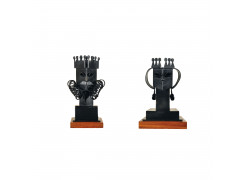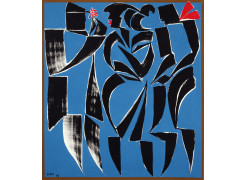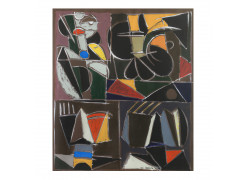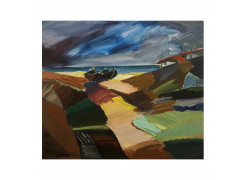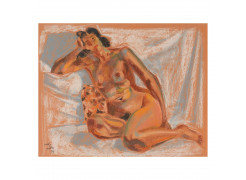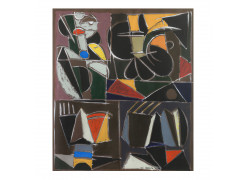Additional info:
Hussein Madi’s artistic formation unfolded between Beirut and Rome, where his education at the Lebanese Academy of Fine Arts and subsequently at the Accademia di Belle Arti cultivated a disciplined understanding of form, structure and proportion. His extended residence in Italy during the 1960s and 1970s, coupled with regular teaching at the Lebanese University’s Institute of Fine Arts, consolidated a visual language that fused a Mediterranean sensibility with the analytical rigour of modernist thought. Madi’s practice encompasses painting, sculpture, engraving and graphic art, unified by a sustained inquiry into the geometry of nature and the structural logic of living forms. Although his compositions verge on abstraction, they remain firmly anchored in figuration and in the observable world, consistent with his belief in the primacy of vision and direct perception. This equilibrium between abstraction and representation defines his exploration of repetition, rhythm and symmetry. Recurring motifs—birds, bulls and human figures—evolve into archetypal signs that evoke both the order of creation and the metaphysical unity underlying multiplicity. The discipline of construction and the precision of contour align his work with Islamic artistic thought, particularly in its emphasis on geometry, modularity and infinite variation. His serial arrangements of shapes—structured within grids or set in diagonal or undulating sequences—suggest both mathematical order and a meditative, almost liturgical rhythm. In his metal sculptures, these same linear schemes acquire volume through bending and folding, translating the syntax of drawing into tangible space while preserving its purity of line. While references to Matisse and Picasso are discernible in his chromatic restraint and formal economy, Madi’s visual vocabulary stands apart in its synthesis of spiritual geometry and tactile materiality. His lifelong dialogue between the figurative and the abstract, between Western modernism and Arab visual heritage, has secured his position as one of the most articulate and enduring voices in twentieth-century Middle Eastern art.
-
Corina Beiu Angheluță
Câmpina, Romania, 1919 - Bucharest, Romania, 2009 -
Eugen Tăutu
Sibiu, Romania, 1945 - Sibiu, Romania, 2018 -
Amadeo Modigliani
Livorno, Italy, 1884 - Saint-Étienne, France, 1920 -
Karl Prantl
Pöttsching, Austria, 1923 - Pöttsching, Austria, 2010 -
József Ács
Backa Topola, Serbia, 1914 - Novi Sad, Serbia, 1990
